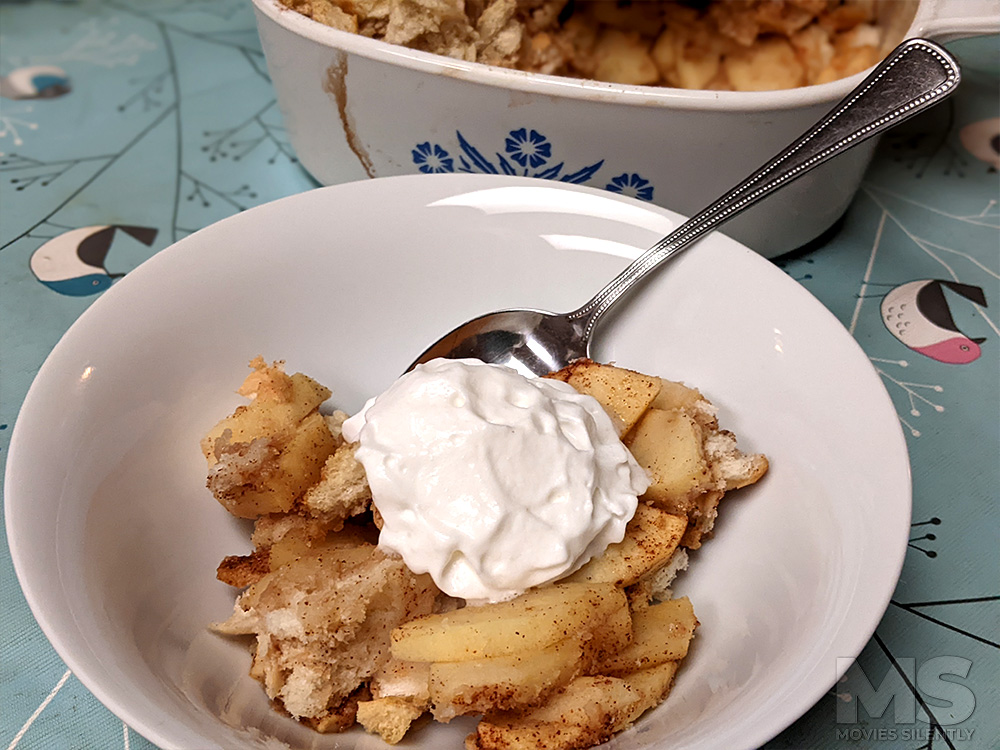It’s been ages since I have posted a recipe, so if this is your first time, I’m cooking my way through the 1929 Photoplay Cookbook and I’m inviting you to tag along. This time, we’ll be testing out an apple dessert from one of the silent era’s horror icons.
(You can catch up on all my taste tests here.)
I’ve been on a little bit of a cooking hiatus but when Karie Bible of Hollywood Kitchen invited me to join her Women in Horror collaboration, I knew I had just the recipe! You’ll also want to catch Karie’s video episode tomorrow, October 8, 2022. Here is the full roster of participants:
Silver Screen Suppers (Jenny Hammerton)
Samantha Ellis
Angie Schneider
And me!
Our featured star recipe is from Mary Philbin. Even the most casual movie fan has likely seen at least one of her movies as she was the leading lady of both The Phantom of the Opera and The Man Who Laughs, classics of the macabre. She’s an interesting figure in that she wasn’t a terrific actress (Conrad Veidt seemed to coax the best out of her) but her filmography has kept her in the public eye for nearly a century. For what it’s worth, she seemed to have been a perfectly lovely person and her dead accurate recall (backed by what we see on film) makes her a valuable source of silent era trivia.
Philbin’s recipe is a simple one. As with all stars, we are not 100% sure if she actually made this but it is a thrift dessert, a variation on the Brown Betty.
Most Brown Betty recipes I have seen involve more of a streusel affair with butter and flour and sugar. This seemed more like a bread pudding situation, which was fine by me because I love bread pudding. The recipe emphasizes its thriftiness, so in that spirit, I used some plain French bread, which is unenriched with eggs or milk. I did, however, use the suggestion to include lemon and butter because I find vintage American recipes can be cloyingly sweet without something to cut the sugar. I also dialed back the cinnamon because it’s not my favorite spice. Obviously, this recipe can be made vegan with the use of raw sugar and the plant-based fat of your choice.
I peeled and sliced the apples and began layering. I used a more rustic bread crumb here and I refuse to say whether or not is was because I was a little lazy. Anyway, I dabbed in some butter and into the oven it went. As with all fruit desserts, I made sure to put a sheet pan under the baking dish to catch drips, which did occur here.
I baked it for 350 degrees, my go-to when testing vintage recipes but I think I could have either raised it to 400 or left the dessert in a little longer as the apples were still al dente. The bread crumbs were also a bit dry but that might have been my fault for not going for smaller crumbs and better incorporated butter.
The result was exactly what I expected: a bread puddingish apple crumble variation and it tasted swell. Philbin suggests serving with hard sauce (which is basically boozy buttercream that melts over the dessert) but I decided to embrace the cleaner taste of whipped cream.
Score: ★★★ out of ★★★★★
The texture wasn’t ideal but at the end of the day, it was tree ripe apples with cinnamon, sugar and a dash of lemon. There’s no way this could possibly fail to taste good. If I were to make it again, I would probably go for an enriched bread like brioche to chase away dryness and perhaps incorporate some of that booze into the apple mixture itself.
Still, my taste testers went for seconds, the house smelled divine and it was indeed a cheap dessert to make. Mission accomplished for Mary Philbin, I think.
☙❦❧
Like what you’re reading? Please consider sponsoring me on Patreon. All patrons will get early previews of upcoming features, exclusive polls and other goodies.
Disclosure: Some links included in this post may be affiliate links to products sold by Amazon and as an Amazon Associate I earn from qualifying purchases.









I love your recipe series!!
I’ve never made a Brown Betty but this sounds like fun.
Thank you! It was quite nice, though I would mess around with the ingredients a bit to keep things from getting too dry.
Glad to see another one of this series. I don’t make them, but do enjoy seeing you doing it and reporting on their taste. I suspect 1910s-1930s deserts were so sweet, because the main courses were so less sweet back then. Looking forward to the next one.
Plus, I think the fruit was probably better tasting and more complex generally. I used local tree-ripe apples and the difference is astonishing.